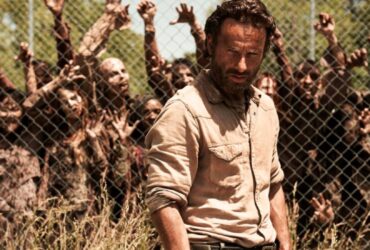Launching in the new year, Netflix’s American Primeval spotlights life on the American Frontier during 1857. It examines how a culturally diverse group of people, including Mormons, Native Americans, and mercenaries, attempt to survive and coexist with each other, with the constant threat of war and death looming. The show is directed by the talented Peter Berg, whose filmography includes the likes of The Kingdom and Deepwater Horizon, and features an ensemble cast headed up by Taylor Kitsch.
In a recent interview, Game Rant caught up with director Peter Berg, Taylor Kitsch (Isaac), Betty Gilpin (Sara), Derek Hinkey (Red Feather), Saura Lightfoot-Leon (Abish), and Julie O’Keefe, who served as the Indigenous Consultant. They shared their experiences while working on the Netflix series, including some of the toughest aspects of filming and the focus on cultural differences. This interview has been edited for clarity and brevity.

Related
What Happened To Netflix’s Horizon Zero Dawn Series?
Horizon Zero Dawn was set for a TV series adaptation on Netflix. Here’s why things fell apart.
American Primeval’s Cast On Their Experiences On Set
Q: Taylor, how did it feel to be stepping into a story set in such an intense, important time period?
Kitsch: On and off camera, I think that the more the responsibility, the more game you should be. I loved it. I learned an incredible amount from the Native American community, from simple things like horseback riding to pieces of history that had happened that I had literally no idea about. I live in Montana, so my place looks out to the Bridger Mountains. Learning about Bridger and these real people that changed the course of the West was amazing. I love that Shea Whigham brought him to life. Damn, he’s good in this show!
On my way to Santa Fe I drove to the Shoshone reservation, and then I went through Fort Bridger. I even went to where some of these people are buried in Wyoming. So you’re going through these pieces of history that are tied to the show. That was incredible, and just so motivating, if you aren’t already motivated enough! It was all these pieces that added up to just loving this responsibility and trying to take ownership as much as you can.
Q: Betty, how did the experience of working on a historical drama like this affect your understanding of frontier life and women’s roles during that time?
Gilpin: I did a lot of research on what Sara’s life would have been like. I think in a lot of historical retellings of that time period, some elements regarding women are left out because they’re sort of almost just handmaids. It’s depressing to fully take in. Sara wouldn’t have been allowed to take a walk down the street by herself. Reading a novel would be frowned upon. Her focus should be on being quiet in a room, letting other people talk, or just focusing on marrying the right guy and having a kid and maybe throwing a tea party and reading the Bible and staring out the window depressed.
I imagine Sara was told that that was her highest purpose in life, being thrust into a world where it’s all about survival. There are no manners, there are no rules, and it must have been so initially terrifying, but also sort of freeing in a strange way. Realizing, okay, yes, I’m incredibly unsafe here, I’ll probably freeze to death or get killed, but that means no one cares if I take the reins of my own life here. There are bigger fish to fry than whether I’m not sitting correctly. I think that there’s both a fear and freedom for Sara, of being in this world.
American Primeval Director Explains Show’s Concept
Q: Peter, what drew you to create a series set on the American frontier, and what were some of the unique challenges in bringing this period to life on screen?
Berg: Mark Smith, who wrote the script, and I, when we sat down to try and come up with something that we wanted to do together because we’re big fans of each other, we had a shared love for a movie called Jeremiah Johnson that Robert Redford starred in way back. It’s a really good movie, and it wasn’t a traditional Western. It was more of a survival tale.
Something that Mark and I were both talking about was the current state of the world and the amount of violence that we were seeing every day in the United States, Europe, Asia, South America, etc. We wanted to do something to sort of explore what it is that makes men want to be violent against each other, so often, in so many different ways, and it was sort of our desire to explore violence—the themes of violence—with our desire to do something in a period environment that led us to 1857, Southern Utah, and American Primeval.
Q: How did you balance historical accuracy with telling a compelling story?
Berg: People like the extremely talented Julie O’Keefe were very helpful. There was just so much that I didn’t know, and I was able to lean on an incredible group of consultants, not just with the Native Americans, but with the Mormon representation, and with the military representation. We had the curator of the Fort Bridger Museum, who was out there every day making sure that I understood everything I needed to understand about what it meant to be a mountain man in Wyoming in 1857.
Having great consultants helped so much. They felt empowered to make us understand what we didn’t understand, and if we were getting something wrong, to say, “No, it doesn’t look like this, it looks like this. No, it doesn’t sound like that. It sounds like this.” We were very receptive to that. That’s how I’ve always tried to approach the great majority of my films, from a place of authenticity and telling real stories. So that was all very important, and it really starts and stops with, for me, the research, and then the hiring of really talented consultants who are not afraid to tell you, and we have to hear that.
Q: What would you say the hardest role to cast was, and why?
Berg: Probably the hardest role, if I’m going to be honest, was the wolves, because they’re dangerous and hard to direct! If you get too close to them, they attack you. Communicating with them was difficult, and then getting them to jump through the windows and attack the stuntmen that we wanted them to attack was probably the single most difficult bit of directing I had to do because I had such a great cast. They were much easier than the wolves. So I’m going to go with the wolves!

Related
Black Mirror: Bandersnatch & Why Netflix’s Interactive Titles Didn’t Last
The rise and fall of titles like Bandersnatch and why audiences never fully embraced the format. Why did Netflix’s interactive films and shows fail?
Indigenous Consultant Julie O’Keefe on What She Hopes the Audience Takes Away
Q: Julie, what do you hope that people understand more about Native culture after watching this show?
O’Keefe: Definitely language. We’re preserving the language. You know, there are 574 federally recognized tribes in the United States, and we’re all making a concerted effort to save our language. Because without that, who are we? When you wake up in the morning if you had no language, who would you be?
We have 3700 words within the script, and we have involved three different Native American tribes; Southern Paiute, Shoshone, and Ute. That’s really what I want people to sit down and think about, and the fact that we’re preserving that in today’s time. We’re not relics, we’re preserving this in today’s time.
How Derek Hinkey’s Native American Background Influenced His Role in American Primeval
Q: Derek, how did your own cultural background influence your portrayal of your character, especially in terms of representing Native American perspectives within the story?
Hinkey: I think it was just being real. You know, I grew up on a reservation, so it’s just genetic memory, being real, but also tapping into that skill set and craft of learning how to relay that message to people.
Q: How does the series address themes of resilience and survival from an indigenous perspective, and what was important for you to convey through your performance?
Hinkey: There’s always been a lot going on. Some people call it trauma, some people call it negativity or whatnot. But, I was always taught as a kid that you have a bottle inside of you, and when that happens, you take that negativity, put it in this bottle, and turn that into positive energy and redirect it into the world. So that’s kind of what I used. It’s a medicine.
Q: Which part of the role would you say felt closest to you personally, and why?
Hinkey: Doing what I thought was right to protect my people and the community.
Q: Saura, how did you approach portraying a character in this time period, and specifically what was the most difficult aspect about it?
Lightfoot-Leon: I would say, the most difficult aspect was the reality of wearing actual clothing from the period. I wore a corset throughout. There’s this famous Mormon look, which is the dress, and the reality of having to physically fight for your life and everything that my character goes through, it’s tough, like even breathing is tough in it. As soon as I took that corset off, I was like, man, I take breathing for granted! They really went through a whole different set of problems back in the day.
How American Primeval Cast Ensured Historical Authenticity
Q: How did you find the experience of balancing historical authenticity with the story and trying to get that balance right?
Lightfoot-Leon: It was delicate. Definitely, as an actor, I want to get things right. As a person, I want to get things right. I knew there had to be an element of academic, but also human research. The best part is the human research, reading books, listening to podcasts, going to Mormon church, meeting people—then going to Santa Fe and being around incredible native talent, being on sacred land, hearing stories, laughing, that’s the best part of the job. That is why I do what I do.
Q: What’s the one thing that you’ll take away from the experience?
Lightfoot-Leon: Riding a horse! I’d never ridden a horse before this, and I loved it. I miss it. I don’t get to do it here in London, and it’s a gift.
[END]
American Primeval streams on Netflix on January 9, 2025.

Netflix
- founded
- August 29, 1997
- notable shows
- Stranger Things , The Witcher , orange is the new black















Leave a Reply